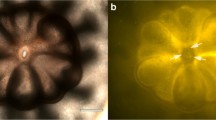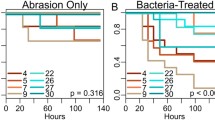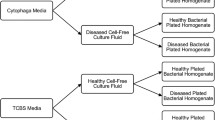Abstract
Environmental conditions greatly impact the dynamics of host–pathogen relationships, affecting outbreaks and emergence of new diseases. In corals, epizootics have been a main contributor to the decline of reef ecosystems and rising sea surface temperatures associated with climate change are thought to exacerbate virulence of pathogens and/or compromise the immune responses of coral hosts. Among pathogens strategies, protease secretion is a common virulence factor that promotes colonization of the host. As such, protease inhibitors play an invaluable role to the host for protection against pathogen invasion. This study describes changes in activity of proteases secreted by the fungal pathogen, Aspergillus sydowii, and protease inhibitors of Gorgonia ventalina under ambient and elevated temperatures and health conditions (disease and healthy). G. ventalina colonies were collected from Florida Keys, Florida (24° 34.138N, 81° 22.905W) or La Parguera, Puerto Rico (17° 56.091N, 67° 02.577W) in 2007 and 2012, respectively. At elevated temperatures, protease activity was significantly higher than at ambient temperatures in A. sydowii. Temperature stress did not induce a change in protease inhibitor activity, but in healthy G. ventalina colonies, inhibitor activity against proteases was higher than in diseased individuals. Healthy colonies appear capable of resisting proteolytic activity, but diseased individuals are still likely affected by pathogen infections. These data suggest that rising sea surface temperatures due to climate change may increase levels of virulence (protease activity) of A. sydowii, while immunity (protease inhibitor) of G. ventalina may not be affected.



Similar content being viewed by others
References
Alker AP, Smith GW, Kim K (2001) Characterization of Aspergillus sydowii (Thom et Church), a fungal pathogen of Caribbean sea fan corals. Hydrobiologia 460:105–111
Altizer S, Ostfeld RS, Johnson PTJ, Kutz S, Harvell CD (2013) Climate change and infectious diseases: from evidence to a predictive framework. Science 341:514–519. doi:10.1126/science.1239401
Armstrong PB (2006) Proteases and protease inhibitors: a balance of activities in host–pathogen interaction. Immunobiology 211:263–281
Asis R, Muller V, Barrionuevo DL, Araujo SA, Aldao MA (2009) Analysis of protease activity in Aspergillus flavus and A. parasiticus on peanut seed infection and aflatoxin contamination. Eur J Plant Pathol 124:391–403. doi:10.1007/s10658-008-9426-7
Bond JS, Butler PE (1987) Intracellular proteases. Annu Rev Biochem 56:333–364. doi:10.1146/annurev.bi.56.070187.002001
Bruno JF, Ellner SP, Vu I, Kim K, Harvell CD (2011) Impacts of aspergillosis on sea fan coral demography: modeling a moving target. Ecol Monogr 81:123–139
Burge CA, Mouchka ME, Harvell CD, Roberts S (2013) Immune response of the Caribbean sea fan, Gorgonia ventalina, exposed to an Aplanochytrium parasite as revealed by transcriptome sequencing. Front Physiol 4
Cerenius L, Soderhall K (2004) The prophenoloxidase-activating system in invertebrates. Immunol Rev 198:116–126
Cohen BL (1973) Regulation of intracellular and extracellular neutral and alkaline proteases in Aspergillus nidulans. J Gen Microbiol 79:311–320. doi:10.1099/00221287-79-2-311
Donpudsa S, Tassanakajon A, Rimphanitchayakit V (2009) Domain inhibitory and bacteriostatic activities of the five-domain Kazal-type serine proteinase inhibitor from black tiger shrimp Penaeus monodon. Dev Comp Immunol 33:481–488
Dunaevskii YE, Gruban TN, Belyakova GA, Belozerskii MA (2006) Extracellular proteinases of filamentous fungi as potential markers of phytopathogenesis. Microbiology 75:649–652. doi:10.1134/S0026261706060051
Faisal M, MacIntyre E, Adham K, Tall B, Kothary M, La Peyre J (1998) Evidence for the presence of protease inhibitors in eastern (Crassostrea virginica) and Pacific (Crassostrea gigas) oysters. Comp Biochem Physiol B 121:161–168
Flynn K, Weil E (2009) Variability of aspergillosis in Gorgonia ventalina in La Parguera, Puerto Rico. Caribb J Sci 45:215–220
Geiser DM, Taylor JW, Ritchie KB, Smith GW (1998) Cause of sea fan death in the West Indies. Nature 394:137–138
Gil-Agudelo DL, Myers C, Smith GW, Kim K (2006) Changes in the microbial communities associated with Gorgonia ventalina during aspergillosis infection. Dis Aquat Org 69:89
Gil-Turnes M, Hay M, Fenical W (1989) Symbiotic marine bacteria chemically defend crustacean embryos from a pathogenic fungus. Science 246:116–118. doi:10.1126/science.2781297
Hanzi M, Shimizu M, Hearn VM, Monod M (1993) A study of the alkaline proteases secreted by different Aspergillus species. Mycoses 36:351–356
Harvell D (2004) Ecology and evolution of host-pathogen interactions in nature. Am Nat 164:S1–S5
Harvell CD, Mitchell CE, Ward JR, Altizer S, Dobson AP, Ostfeld RS, Samuel MD (2002) Climate warming and disease risks for terrestrial and marine biota. Science 296:2158–2162
Hedayati M, Pasqualotto A, Warn P, Bowyer P, Denning D (2007) Aspergillus flavus: human pathogen, allergen and mycotoxin producer. Microbiology 153:1677–1692
Hoegh-Guldberg O, Bruno JF (2010) The impact of climate change on the world’s marine ecosystems. Science 328:1523–1528
Hoge R, Pelzer A, Rosenau F, Wilhelm S (2010) Current research, technology and education topics in applied microbiology and microbial biotechnology. In: Mendez-Vilas A (ed) Weapons of a pathogen: proteases and their role in virulence of Pseudomonas aeruginosa. Formatex Research Center, Badajoz
Jongsma MA, Bolter C (1997) The adaptation of insects to plant protease inhibitors. J Insect Physiol 43:885–895
Kim K, Harvell CD (2004) The rise and fall of a six-year coral-fungal epizootic. Am Nat 164:S52–S63
Kim J-Y, Park S-C, Hwang I, Cheong H, Nah J-W, Hahm K-S, Park Y (2009) Protease inhibitors from plants with antimicrobial activity. Int J Mol Sci 10:2860–2872
Krull R, Cordes C, Horn H, Kampen I, Kwade A, Neu TR, Nörtemann B (2010) Morphology of filamentous fungi: linking cellular biology to process engineering using Aspergillus niger biosystems engineering II. Springer, Heidelberg, pp 1–21
Kulshrestha V, Pathak S (1997) Aspergillosis in German cockroach Blattella germanica (L.)(Blattoidea: blattellidae). Mycopathologia 139:75–78
Lee CY, Cheng MF, Yu MS, Pan MJ (2002) Purification and characterization of a putative virulence factor, serine protease, from Vibrio parahaemolyticus. FEMS Microbiol Lett 209:31–37
Little TJ, Hultmark D, Read AF (2005) Invertebrate immunity and the limits of mechanistic immunology. Nat Immunol 6:651–654
McGillivray SM, Tran DN, Ramadoss NS, Alumasa JN, Okumura CY, Sakoulas G, Vaughn MM, Zhang DX, Keiler KC, Nizet V (2012) Pharmacological inhibition of the clpxp protease increases bacterial susceptibility to host cathelicidin antimicrobial peptides and cell envelope-active antibiotics. Antimicrob Agents Chemother 56:1854–1861
McManus M, White DR, McGregor P (1994) Accumulation of a chymotrypsin inhibitor in transgenic tobacco can affect the growth of insect pests. Transgenic Res 3:50–58. doi:10.1007/BF01976027
Monod M, Capoccia S, Lechenne B, Zaugg C, Holdom M, Jousson O (2002) Secreted proteases from pathogenic fungi. Int J Med Microbiol 292:405–419
Mydlarz LD, Harvell CD (2007) Peroxidase activity and inducibility in the sea fan coral exposed to a fungal pathogen. Comp Biochem Physiol A Mol Integr Physiol 146:54–62
Mydlarz LD, Holthouse SF, Peters EC, Harvell CD (2008) Cellular responses in sea fan corals: granular amoebocytes react to pathogen and climate stressors. Plos One 3(3):e1811. doi:10.1371/journal.pone.0001811
Mydlarz LD, McGinty ES, Harvell CD (2010) What are the physiological and immunological responses of coral to climate warming and disease? J Exp Biol 213:934–945
Novillo C, Castañera P, Ortego F (1997) Inhibition of digestive trypsin-like proteases from larvae of several lepidopteran species by the diagnostic cysteine protease inhibitor E-64. Insect Biochem Mol Biol 27:247–254
Palmer CV, McGinty ES, Cummings DJ, Smith SM, Bartels E, Mydlarz LD (2011) Patterns of coral ecological immunology: variation in the responses of Caribbean corals to elevated temperature and a pathogen elicitor. J Exp Biol 214:4240–4249
Pandolfi JM, Connolly SR, Marshall DJ, Cohen AL (2011) Projecting coral reef futures under global warming and ocean acidification. Science 333:418–422
Petes LE, Harvell CD, Peters EC, Webb MAH, Mullen KM (2003) Pathogens compromise reproduction and induce melanization in Caribbean sea fans. Mar Ecol Prog Ser 264:167–171
Rahim MA, Bakhiet AO, Hussein MF (2013) Aspergillosis in a gyrfalcon (Falco rusticolus) in Saudi Arabia. Comp Clin Pathol 22:131–135
Rolff J, Siva-Jothy MT (2003) Invertebrate ecological immunology. Science 301:472–475. doi:10.1126/science.1080623
Ruiz-Morenol D, Willis BL, Page AC, Weil E, Cróquer A, Vargas-Angel B, Jordan-Garza AnG, Jordán-Dahlgren E, Raymund L, Harvell CD (2012) Global coral disease prevalence associated with sea temperature anomalies and local factors. Dis Aquat Org 100:249–261
Rypien KL, Andras JP (2008) Isolation and characterization of microsatellite loci in Aspergillus sydowii, a pathogen of Caribbean sea fan corals. Mol Ecol Res 8:230–232
Rypien KL, Andras JP, Harvell C (2008) Globally panmictic population structure in the opportunistic fungal pathogen Aspergillus sydowii. Mol Ecol 17:4068–4078
Schomburg I, Chang A, Placzek S, Söhngen C, Rother M, Lang M, Munaretto C, Ulas S, Stelzer M, Grote A, Scheer M, Schomburg D (2013) BRENDA in 2013: integrated reactions, kinetic data, enzyme function data, improved disease classification: new options and contents in BRENDA. Nucleic Acids Res 41(Database issue):D764–D772
Sugumaran M, Saul SJ, Ramesh N (1985) Endogenous protease inhibitors prevent undesired activation of prophenoloxidase in insect hemolymph. Biochem Biophys Res Commun 132:1124–1129. doi:10.1016/0006-291X(85)91923-0
Sunde J, Taranger G, Rungruangsak-Torrissen K (2001) Digestive protease activities and free amino acids in white muscle as indicators for feed conversion efficiency and growth rate in Atlantic salmon (Salmo salar L.). Fish Physiol Biochem 25:335–345
Twining SS (1984) Fluorescein isothiocyanate-labeled casein assay for proteolytic enzymes. Anal Biochem 143:30–34
Van de Ven WJ, Roebroek AJ, Van Duijnhoven HL (1993) Structure and function of eukaryotic proprotein processing enzymes of the subtilisin family of serine proteases. Crit Rev Oncogen 4:115–136
Wang S-L, Chen Y-H, Yen Y-H (2005) Purification and characterization of a serine protease extracellularly produced by Aspergillus fumigatus in a shrimp and crab shell powder medium. Enzyme Microb Technol 36:660–665
Ward JR, Kim K, Harvell C (2007) Temperature affects coral disease resistance and pathogen growth. Mar Ecol Prog Ser 329:115–121
Weiss Y, Forêt S, Hayward DC, Ainsworth T, King R, Ball EE, Miller DJ (2013) The acute transcriptional response of the coral Acropora millepora to immune challenge: expression of GiMAP/IAN genes links the innate immune responses of corals with those of mammals and plants. BMC Genom 14:400
Xue Q-G, Waldrop GL, Schey KL, Itoh N, Ogawa M, Cooper RK, Losso JN, La Peyre JF (2006) A novel slow-tight binding serine protease inhibitor from eastern oyster (Crassostrea virginica) plasma inhibits perkinsin, the major extracellular protease of the oyster protozoan parasite Perkinsus marinus. Comp Biochem Physiol B 145:16–26
Acknowledgments
Research was funded and supported by NSF (OCE-0849799). The authors would like to thank Ernesto Weil (University of Puerto Rico) and Eric Bartels (Mote Marine Laboratory) for aiding in the collection process, field assistance, and transfer of the coral specimens back to the University of Texas at Arlington. We also thank Lindsey Dornberger and April Klein (undergraduates at UTA) for their help with the processing of the sea fan samples and Colleen Burge (Cornell University) for discussions. We also thank the reviewers for valuable comments which considerably improved this manuscript. All samples were collected under Florida Keys National Marine Sanctuary Permit No. 2004-092 and under the specification of research collection permits to the Department of Marine Science UPRM.
Author information
Authors and Affiliations
Corresponding author
Additional information
Communicated by T. Reusch.
Rights and permissions
About this article
Cite this article
Mann, W.T., Beach-Letendre, J. & Mydlarz, L.D. Interplay between proteases and protease inhibitors in the sea fan—Aspergillus pathosystem. Mar Biol 161, 2213–2220 (2014). https://doi.org/10.1007/s00227-014-2499-2
Received:
Accepted:
Published:
Issue Date:
DOI: https://doi.org/10.1007/s00227-014-2499-2




